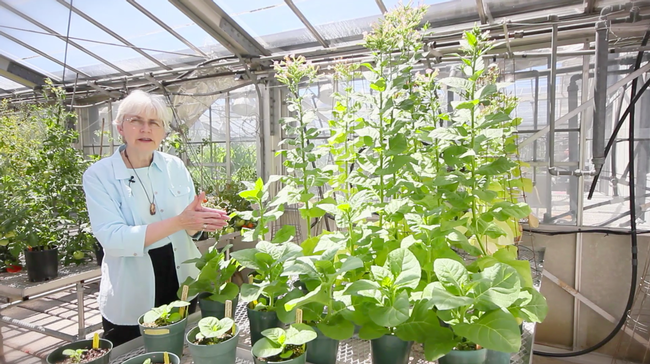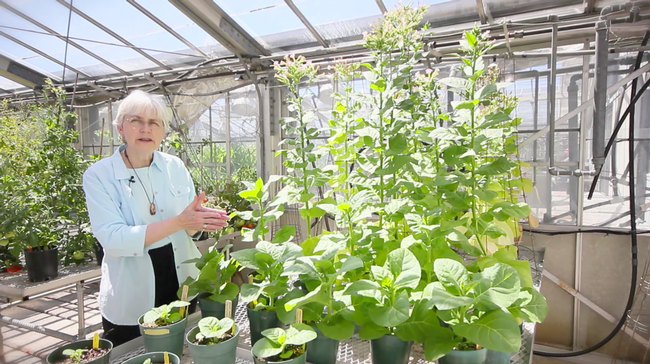Posts Tagged: tobacco
Godzilla Lives!
Remember Godzilla? The 1954 iconic film, Godzilla, featured what Wikipedia calls "an enormous, destructive prehistoric sea monster awakened and...
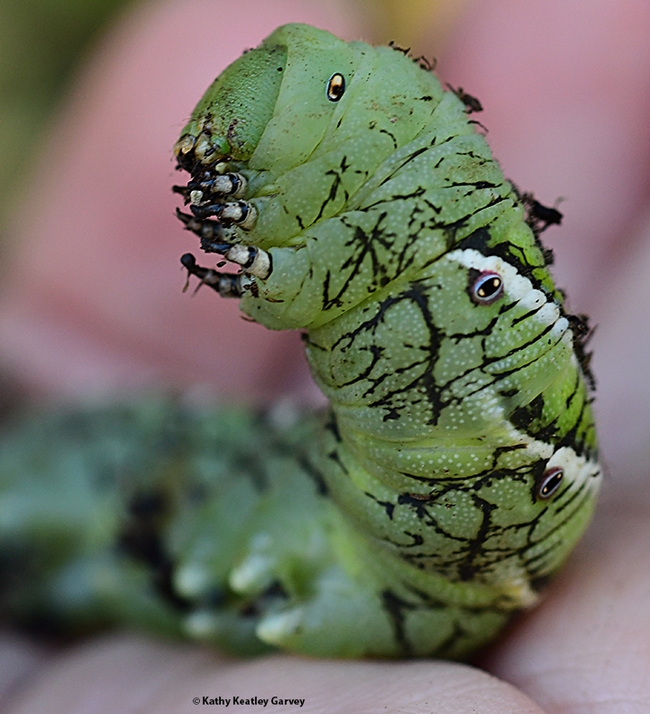
This three-inch-long tobacco hornworm appears to be ready to eat more tomato leaves (or the photographer). (Photo by Kathy Keatley Garvey)
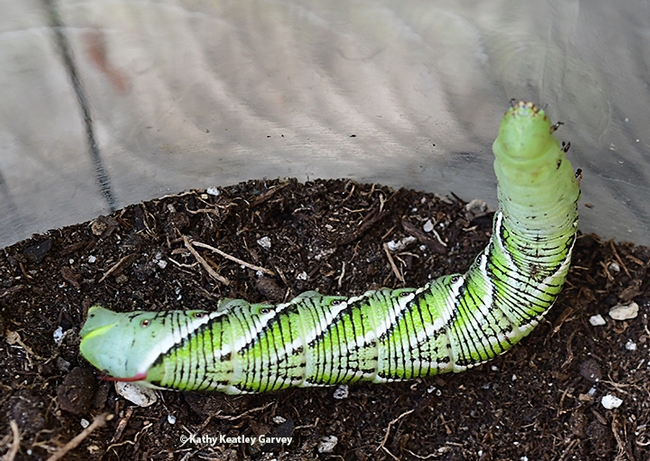
"Godzilla" roaming around her habitat. Tobacco hornworms (Manduca sexta) become Carolina sphinx moths, also known as hawkmoths or tobacco hawkmoths. (Photo by Kathy Keatley Garvey)
The Hornworms Are Not Your Friends
If you love tomatoes, you probably hate hornworms. Frankly, the garden's not big enough for both of you, and one of you has to go. It's not...
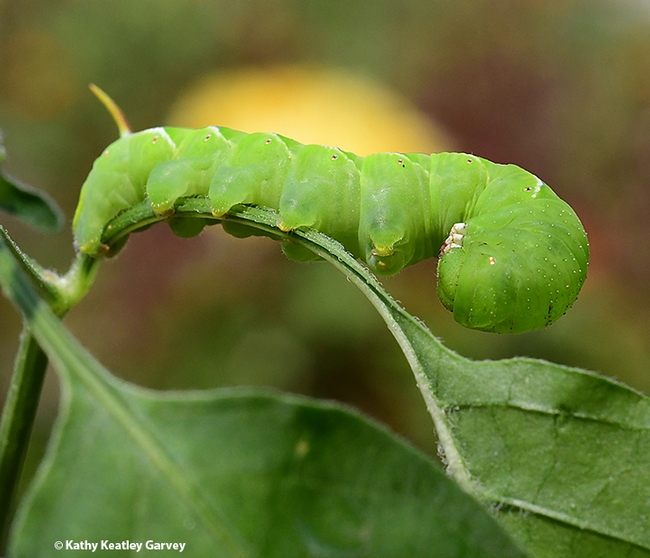
This hornworm is feeding on a pepper plant. (Photo by Kathy Keatley Garvey)
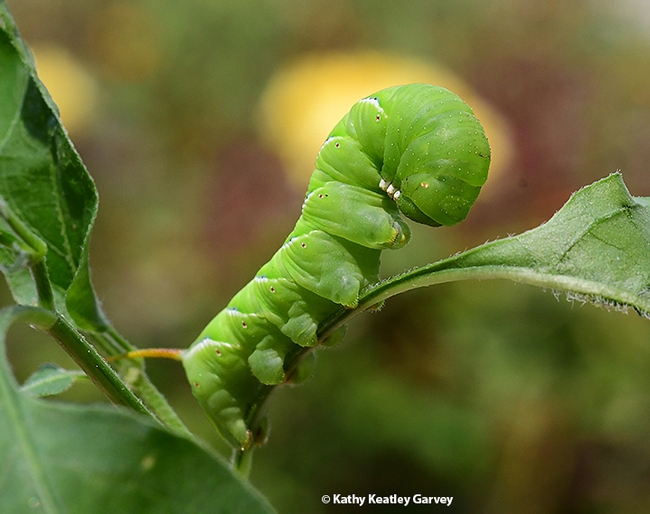
When the caterpillar or larva is disturbed, it "rears up into an Egyptian sphinx-like pose," says entomologist Jeff Smith, curator of the Lepidoptera collection at the Bohart Museum of Entomology. (Photo by Kathy Keatley Garvey)
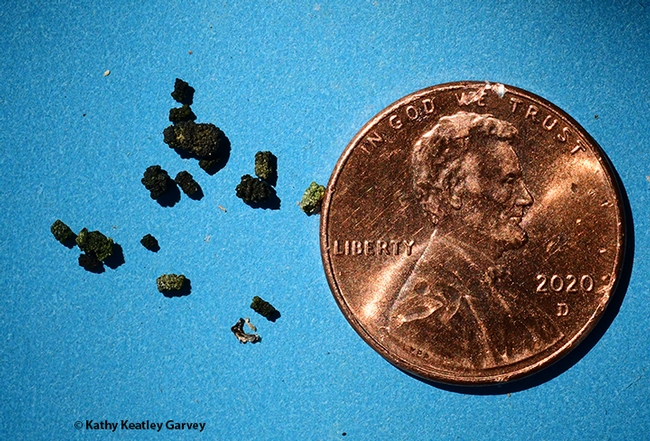
The frass (droppings) from a hornworm. It's a tell-tale sign you have hornworms in your garden. (Photo by Kathy Keatley Garvey)
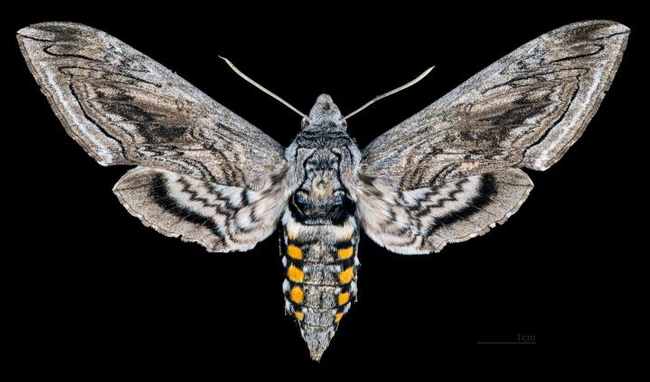
The tomato hornworm turns into a sphinx moth or hummingbird moth (family Sphingidae). (Wikipedia Photo)
UC researchers try to make biofuel in tobacco plants
UC researchers are testing tobacco's potential to be genetically modified in order to produce biofuel, reported Louis Sahagun in the Los Angeles Times' ScienceNow blog.
“The beauty of our proposal is that carbon dioxide emitted into the atmosphere as a byproduct of combustion of these bio-fuels would be captured again by tobacco plants and, through the natural process of photosynthesis, be converted back into fuel," said Anastasios Melis, professor in the Department of Plant and Microbial Biology at UC Berkeley.
Peggy G. Lemaux, UC Cooperative Extension specialist, Melis and Krishna Niyogi, Agricultural Experiment Station faculty in the Department of Plant and Microbial Biology at UC Berkeley, are lead researchers in the project.
For more information and a video growing biofuel in tobacco leaves, see the UC Green Blog.
Additional coverage:
Lemaux and Eduardo Blumwald, professor in the Department of Plant Sciences at UC Davis, were interviewed about biotechnology for a program that will air on the Bay Area’s KQED Channel 9 at 7:30 p.m. May 8. Lemaux and Blumwald will also participate in a "Google Hangout" at 11 a.m. May 8.
Biofuel research may keep tobacco industry from going up in smoke
The troubled tobacco industry may be getting some good news for a change. UC scientists are engineering the tobacco plant to produce oils that, when extracted, can serve as drop-in biofuels to power airplanes, cars and other machines.
Research success would allow farmers who have been growing tobacco for generations to continue the tradition for a different purpose, while taking advantage of an infrastructure established to serve the diminishing cigarette, cigar and snuff markets.
Peggy G. Lemaux, UC Cooperative Extension specialist, and Anastasios Melis and Krishna Niyogi, Agricultural Experiment Station faculty in the Department of Plant and Microbial Biology at UC Berkeley, are lead researchers in the project.
“There are several reasons we are modifying tobacco to produce biofuel,” Lemaux said, “It is a high biomass crop. If you want to extract oil, then the more biomass you have, the more oil you get. And, since tobacco is not a food source, tobacco production for biofuel would not have an impact on global food markets or find its way into the food supply. Finally, tobacco farmers are anxious to produce a product that is more acceptable to the public."
However, there are no tobacco varieties that produce oil at high levels. Scientists know that certain algae do turn sunlight energy into oil, and that sparked an idea.
A research consortium that includes Lemaux, Melis and Niyogi and researchers at the Lawrence Berkeley National Laboratory and the University of Kentucky is taking genes, primarily from algae, that produce oil and inserting them into tobacco plants to make oils in leaves.
To do that, the consortium scientists are using very small pieces of tobacco leaves to introduce the desired algal genes, where they become a heritable trait of the tobacco plant. The small pieces of leaf tissue are then placed in a Petri dish, the tissues that contain the introduced genes identified, and then the tissues grow into a new plant, every cell of which contains the algal genes.
“We hope the new plant will make the same kind of oils that algae do,” Lemaux said. “We can then use organic solvents to extract the oils out of the leaves.”
Much more research is required before tobacco plants that produce biofuel at commercial levels will be available to growers, but Lemaux is encouraged by the preliminary results.
The research is funded with a three-year $4.8 million grant from a U.S. Department of Energy, Advanced Research Projects Agency – Energy program termed PETRO, Plants Engineered to Replace Oil. ARPA-E funds high-risk, high-reward research projects to find potential alternatives to fossil fuels.
See a video about this research below:
UCCE hosts 'Tobacco Jeopardy'
The public is invited to the UC Cooperative Extension office in Solano County tomorrow to take part in "Tobacco Jeopardy," a play on the TV game show that is intended to inform the public on the health effects of tobacco use, reported the Vacaville Reporter.
The event is sponsored by the Solano County Tobacco Prevention and Education Program.
"The goal of the training is to increase public awareness and inspire action to reduce tobacco use and exposure to secondhand smoke in Solano County," said Felicia Flores-Workman of TPEP. "Whatever the audience's level of knowledge about tobacco, they're bound to learn something new."
The free event runs from 10 a.m. to noon Tuesday, Feb. 25, at University of California Cooperative Extension, 501 Texas St., in Fairfield.

Smoking and exposure to tobacco smoke result in approximately 443,000 premature deaths in the U.S. annually, according to the CDC.


